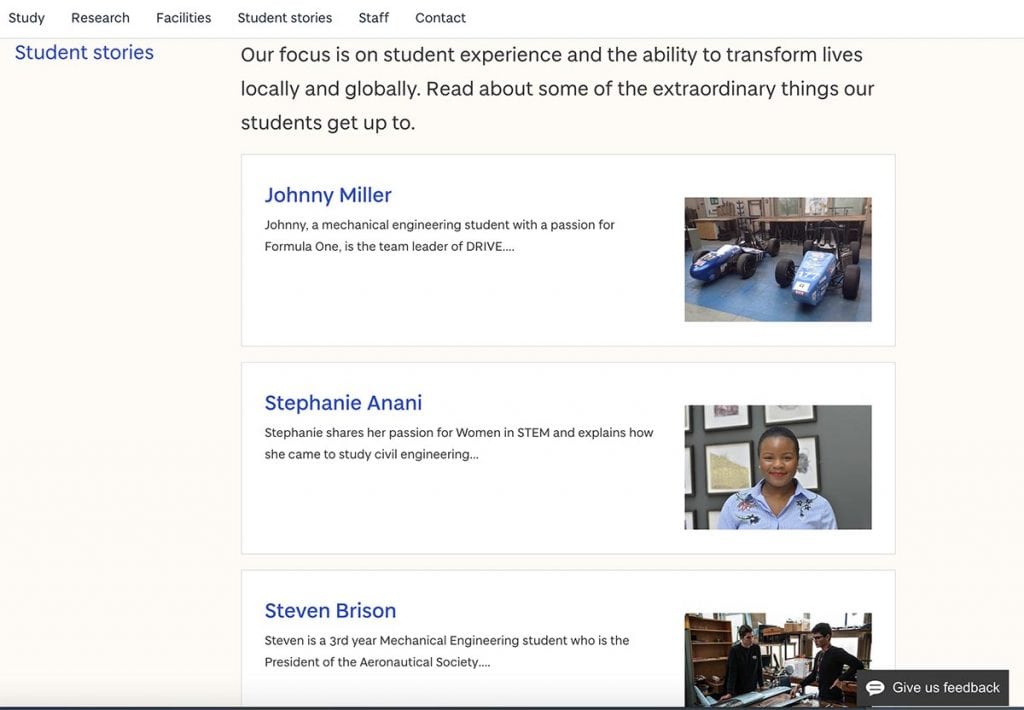We have just finished working with colleagues in Marketing and Engineering to create a new set of web pages. This project was significant for us as it marked a change in the way we deal with common stumbling blocks.
We started with a kick-off meeting to talk about how we would approach the project. These meetings usually include looking at user needs and creating a site structure. We identified our users as prospective students, researchers, and industry.
These web pages have several purposes. Firstly, they complement the information already on the course pages for undergraduate and taught postgraduate students. We wanted to include the rich content that there just isn’t the space for on our course pages: full-length student stories, 360 degree views of the spaces that they will be working in, and information about the student societies they can participate in.
We also wanted to make the pages more useful to researchers. This included providing content about research groups, projects, and case studies.
Finally, the facilities in the Engineering department are some of the best in Scotland, and as such, are attractive to industry. We needed to showcase these on the site.
Everyone is always really enthusiastic at the start of a project and leaves with a list of things to do. This project was no exception. We got some initial content straight away, and soon realised that the original site structure would need to change somewhat.
Because we were working very closely with both Marketing and Engineering, with regular ‘stand up’ meetings to report on progress and discuss any obstacles in our way, we were able to change the site structure straight away. Previously, with less frequent communication, we might have continued down a path which wasn’t quite working for everyone involved, and only changed it later once more work had been done.
After week or so, the flow of content coming in to us started to slow down. This is typical, and is not anyone’s fault – everyone has busy jobs and other priorities. This time though, to keep the flow of this project going we thought it would be good to change our tactics.
Pair-writing is a brilliant approach to most content obstacles and we generate some great writing using it. But something about this project was different and needed a bit more thought. Asking people to sit down and write a case study or about a project can feel really time consuming. Not to mention the edits.
Most people type in a different way than they speak. It is digital versus native language. People will naturally speak with more passion about something they are involved in. If you ask them to sit down to write about it, their language changes, and we lose their voice.
The most effective way to hear their stories was just to listen. We scheduled short 30-minute time slots with staff and recorded everything they said about their projects. When we transcribed these conversations, we had some really rich content.
The enthusiasm, description and tone are completely different and this is something we can give back to the user. It makes our content much more appealing to anyone who reads it.
We did the same with the student stories. Students, understandably, are reluctant to sit down and write something for the website, and when they do, it tends to be what they think we want to hear. Instead of telling us specifics about their course or experience, it can often come across as quite bland and generic.
When we met up with the students, we were able to record conversations in which we asked them questions to tease out their experiences. This way we could share their unique personal stories, and develop content that was genuinely interesting and appealing to prospective students.
A simple and inexpensive dictaphone has really revolutionised the way that we can gather content. It is definitely a technique that we will be employing in future projects.
We will also continue the agile form of working and ensure we have regular, short, sessions with everyone involved. This makes sure there are no crossed wires, obstacles to progress are tackled straight away, and motivation remains high.
Visit the engineering webpages
— Steph Mann and Claire Gregory

